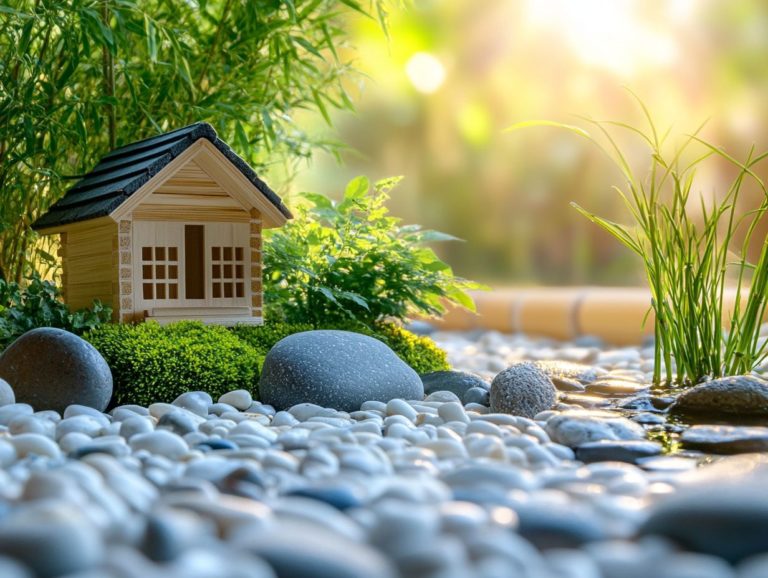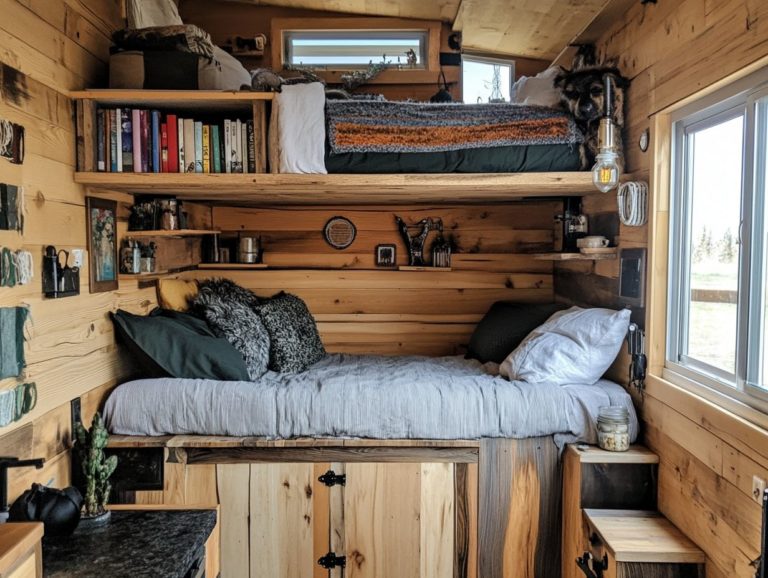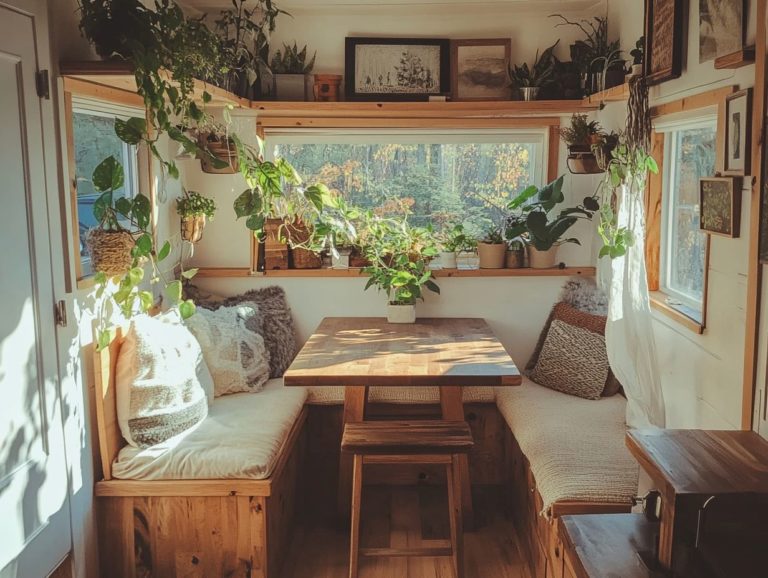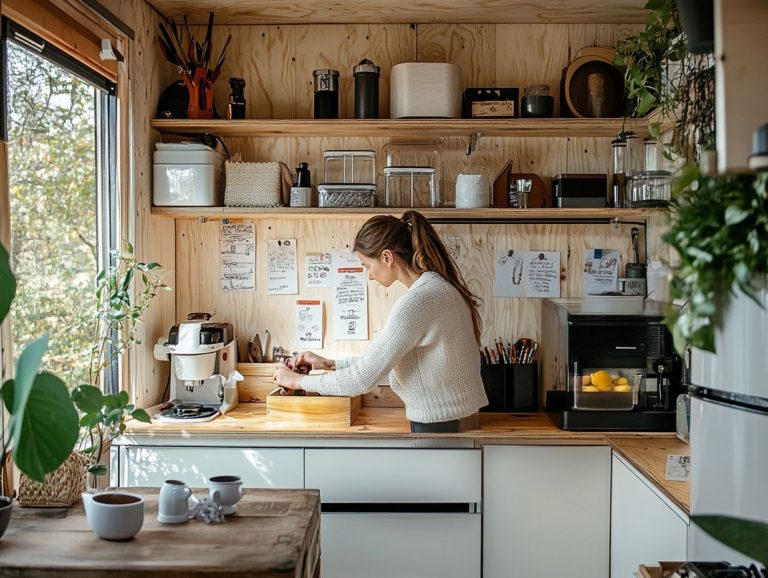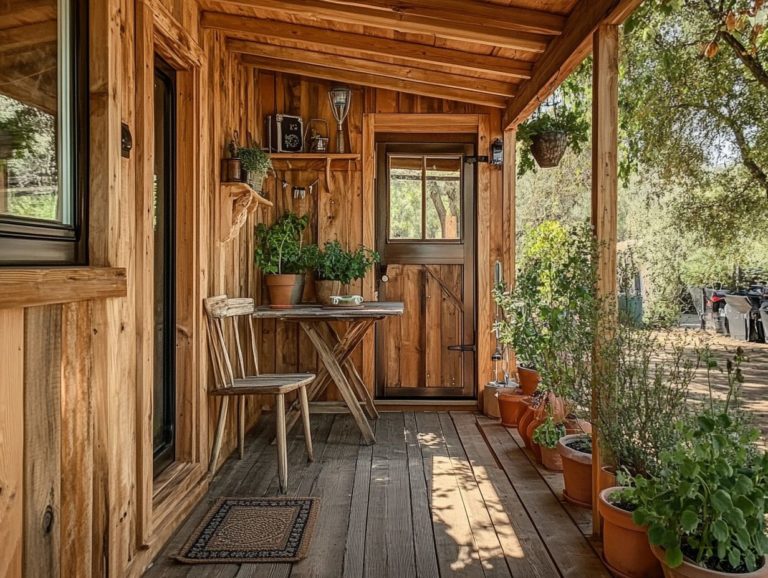How to Build a Tiny House Water Feature
Water features have the remarkable ability to transform your tiny home into a serene oasis, infusing your space with nature’s soothing sounds and captivating sights right at your doorstep. This makes it an ideal patio water feature.
This article delves into the many benefits of incorporating a water feature into your small space. It will guide you in selecting the perfect one and offers a comprehensive DIY approach to crafting it yourself. You ll also uncover essential maintenance tips and explore alternative options to ensure your water feature remains a delightful focal point for years to come.
Immerse yourself in the journey and discover how to cultivate your very own retreat!
Contents [hide]
- Key Takeaways:
- How to Pick the Perfect Water Feature for Your Tiny Home
- Steps for Building a DIY Water Feature
- Maintenance and Care for Your Water Feature
- Alternative Water Feature Options for Tiny Houses
- Frequently Asked Questions
- What materials are needed to build a tiny house water feature?
- How do I choose the right location for my tiny house water feature?
- What is the best type of water pump to use for a tiny house water feature?
- Do I need to use a filter for my tiny house water feature?
- How often should I clean and maintain my tiny house water feature?
- Can I incorporate a tiny house water feature into my existing plumbing system?
Key Takeaways:
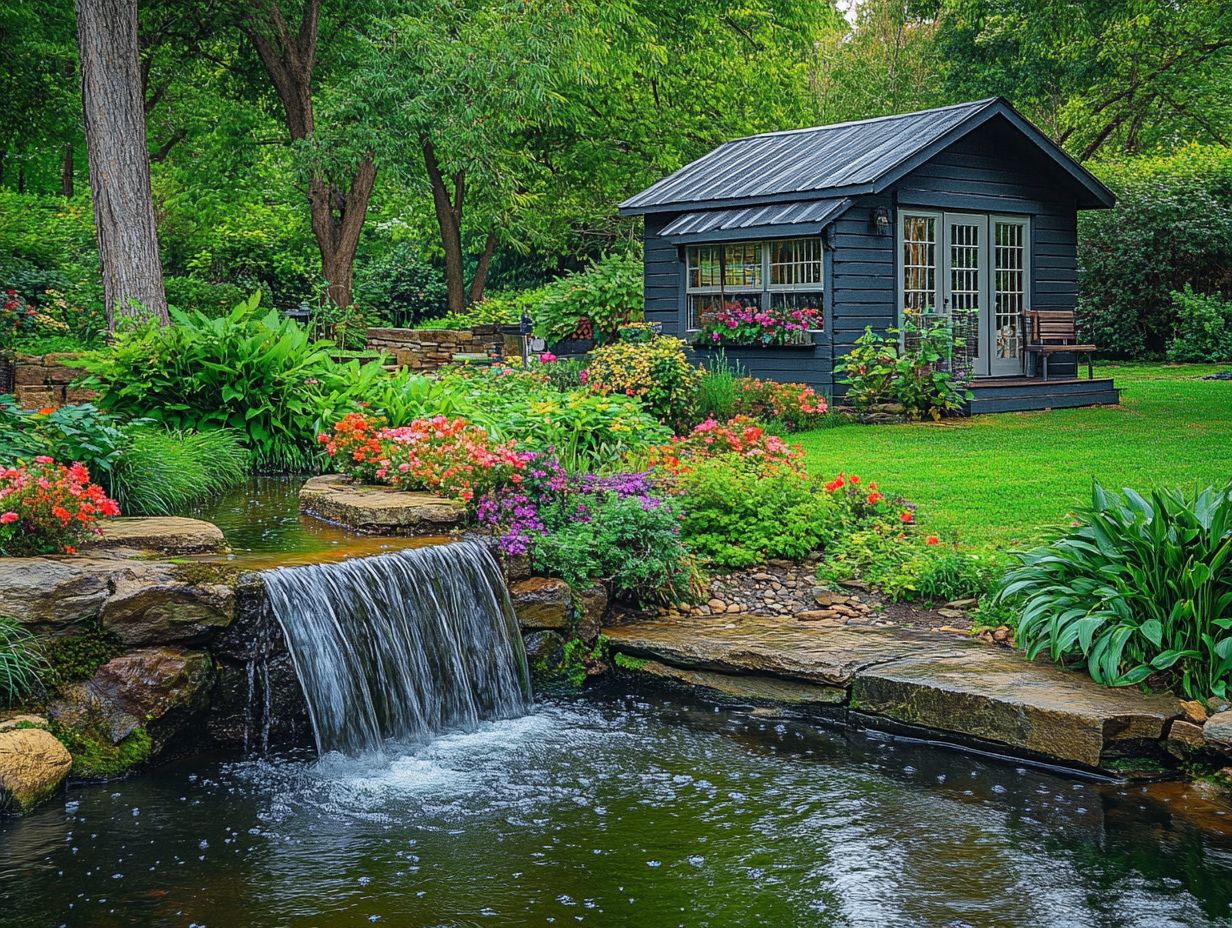
- Water features create a calming atmosphere, boost aesthetics, and attract wildlife.
- Consider size, maintenance, and budget when selecting a water feature.
- Building a DIY feature is rewarding; gather materials and follow a solid plan!
Why You Should Add Water Features
Adding a water feature can truly transform your space into a stunning retreat! Whether it’s a DIY fountain or an elegant stone masterpiece, these features elevate the aesthetic allure and tranquility of your indoor or outdoor areas. They act as natural focal points, providing visual beauty and the soothing sounds of flowing water that create a serene atmosphere, perfect for tiny homes and gardens alike.
You can design them to be maintenance-free, which is a true blessing for busy homeowners or those utilizing systems that reuse water from sinks and showers.
Eco-friendliness is also important, with gravel reservoirs or decorative stones helping to minimize water loss without sacrificing beauty. Your commitment to sustainability is bolstered by employing efficient water circulation systems, cutting down on energy consumption and ensuring your water feature thrives, whether in your garden or indoor sanctuary.
Thoughtful design choices can transform any area into a tranquil oasis, making it an ideal retreat for relaxation and mindfulness.
How to Pick the Perfect Water Feature for Your Tiny Home
When choosing the perfect water feature for your tiny home, it’s essential to assess your available space and the aesthetic effect you wish to achieve.
Whether you lean towards a DIY fountain, a charming stone fountain, or a disappearing fountain that effortlessly integrates into your landscape, the right choice can elevate your environment.
Ensure that the water feature enhances your indoor or outdoor decor while requiring minimal maintenance and promoting efficient water usage, enhancing the eco-friendliness of your compact living space. For inspiration, check out this guide on how to create a tiny house zen garden.
Factors to Consider
When selecting a water feature for your tiny home, consider several critical factors, including available space, budget, and desired aesthetic. The ease of maintenance is paramount; opting for features that require minimal upkeep, such as submersible pumps and eco-friendly tanks, can ease your worries about efficient water usage and plumbing installation.
Evaluating the type and size of the water feature is essential; a compact fountain or a small pond might be a better fit for your limited area than a large waterfall. For more inspiration, check out how to create a tiny house zen space. Your design choices should harmonize with the overall style of your tiny home, ensuring a cohesive look.
Beyond aesthetics, think about water quality management. Implementing filtration systems and conducting regular testing will help you maintain a clean and enjoyable environment. Don t overlook plumbing; efficient water circulation and drainage are vital for the longevity and functionality of your installation.
Steps for Building a DIY Water Feature
Imagine transforming your backyard into a tranquil escape with your own DIY water feature it’s easier than you think! Building a DIY water feature can be an incredibly rewarding endeavor, allowing you to transform your space into a serene oasis with just a few essential steps.
Start by selecting the right materials, such as a liner and gravel reservoir, which are foundational to your project. Next, install a reliable water pump and various fountain fittings to bring your vision to life.
This process not only enables you to create a personalized decorative element but also offers the chance to explore eco-friendly solutions, like greywater recycling systems that reuse water from sinks and showers. This approach can enhance the efficiency of your tiny house s plumbing installation, making your project both beautiful and sustainable.
Gathering Materials and Tools
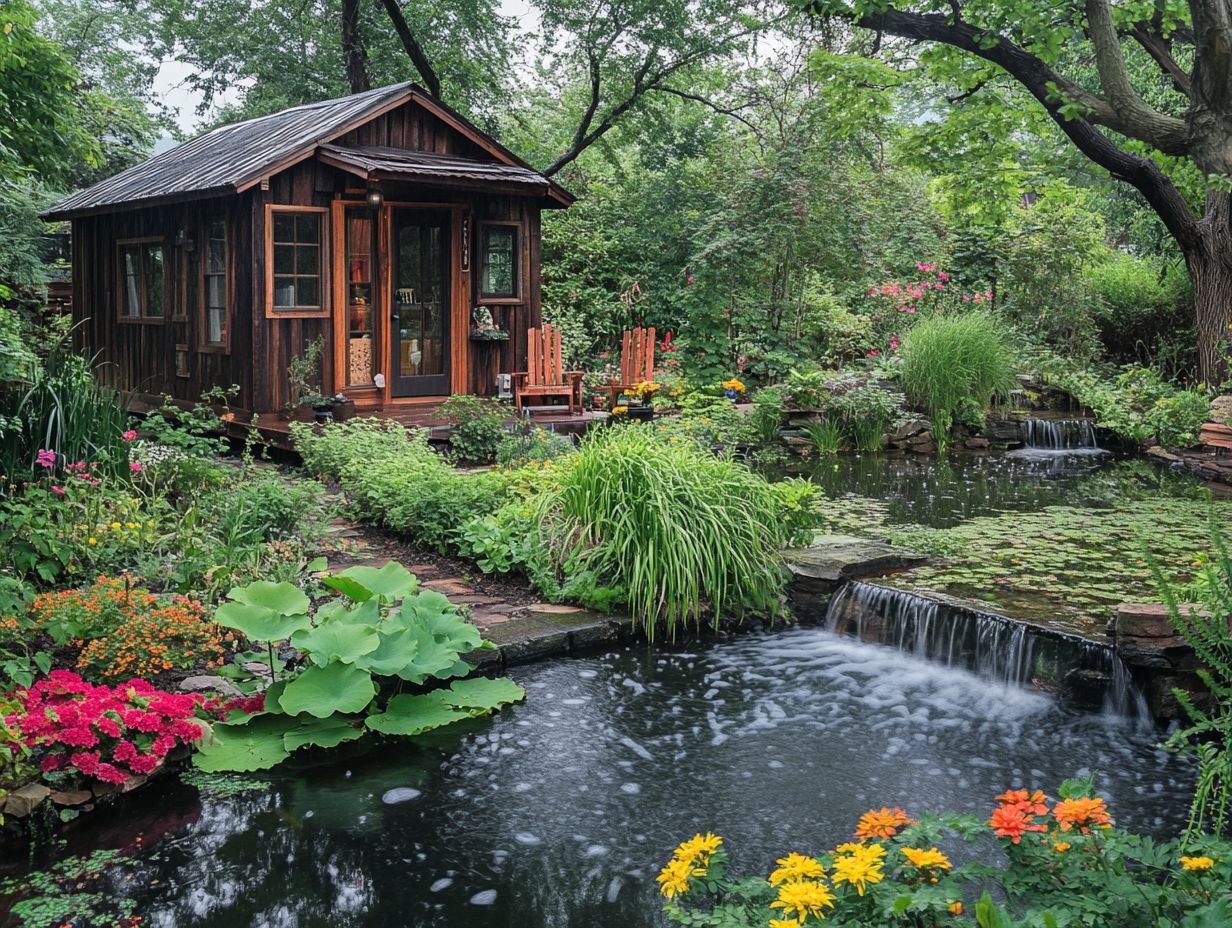
To successfully build your DIY fountain, gathering the right materials and tools is essential. You ll need items such as a water pump, gravel for the base, decorative fountain boulders, and various plumbing parts like hose clamps.
You ll also need safety glasses and a utility knife, along with other essential tools to ensure a smooth construction process. Beyond these foundational items, having a level is crucial for ensuring a stable setup; an uneven fountain can lead to frustrating water pooling or spilling.
A bucket will make pouring gravel and transporting materials a breeze. Let s not overlook waterproof sealant this will prevent leaks and extend the life of your masterpiece.
Using a hose will help you direct water flow precisely, and hose connectors will make this process much easier by ensuring a secure fit. Lastly, keeping a first aid kit nearby will allow you to quickly address any minor injuries during the build, underscoring the importance of safety throughout your construction journey.
Design and Planning
Designing and planning your water feature is an exhilarating phase where you get to envision how the fountain will beautifully enhance your indoor or outdoor space. Consider elements like the style of decorative stones, the overall layout of the feature, and how it will connect with your existing landscaping.
A well-crafted design not only boosts aesthetic appeal but also enhances functionality, creating a harmonious environment in your tiny house. By carefully considering these aspects, you’ll amplify the visual impact while ensuring that the feature serves its intended purpose effectively.
For example, selecting a layout that encourages a natural flow of water can offer soothing sounds while attracting local wildlife. Opting for a style that complements the architecture and nature around you can create a seamless transition between structures and greenery.
Integrating these thoughtful components elevates the overall experience, making your outdoor setting more inviting and enjoyable.
Construction and Installation
The construction and installation of your DIY fountain involves several crucial steps, such as setting up the waterproof liner, assembling the plumbing parts, and securely positioning the water pump to guarantee optimal functionality. Paying close attention to detail during this phase will ensure that your fountain operates smoothly.
To start, it s essential to prepare the site by selecting a level area that can support the fountain s weight and ensure proper water flow. Once you ve laid down the waterproof liner your trusty barrier against leaks it s time to install the plumbing parts with care.
This means connecting the pipes, avoiding any kinks or bends, and checking for leaks like a seasoned pro. After securely positioning the pump, filling the basin with water is your next move.
This step allows you to test the mechanics, making any necessary adjustments to ensure that the fountain not only functions flawlessly but also enhances the beauty of its surroundings.
Maintenance and Care for Your Water Feature
Regular maintenance and care for your water feature are essential to keeping it a breathtaking centerpiece in your space. While many DIY fountains claim to be maintenance-free, it s crucial to engage in periodic cleaning and check the pump connections to ensure optimal water quality and flow.
This diligence not only extends the life of your fountain but also elevates the overall aesthetic appeal of your indoor or outdoor environment. Don’t let neglect ruin your masterpiece maintain it regularly for a stunning display!
Tips for Keeping Your Water Feature Clean and Functional
To keep your water feature pristine and functional, create a cleaning schedule. This tackles overflow water and debris buildup.
Regular cleanings help maintain water quality and ensure the fountain runs smoothly. Using natural cleaning methods makes it easy to enjoy your DIY fountain.
Check the pump and filter regularly to prevent clogs. A simple mix of vinegar and water effectively removes mineral deposits without harsh chemicals.
Adding aquatic plants filters impurities and boosts your fountain’s beauty. Change the water monthly to prevent stagnation and promote healthy circulation.
Using an enzyme-based treatment keeps the microbial balance, making your fountain a serene focal point instead of a maintenance chore.
Alternative Water Feature Options for Tiny Houses
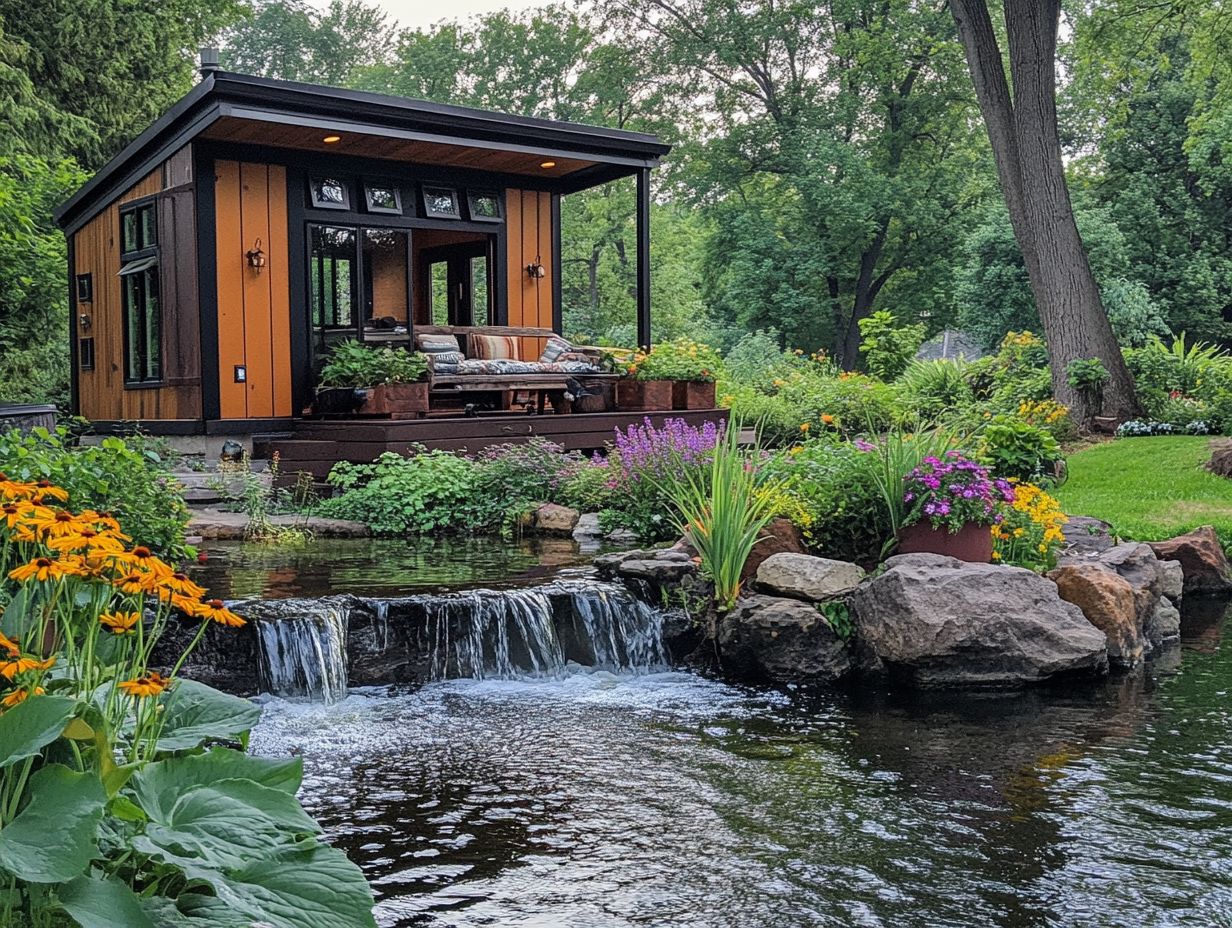
Explore alternative water feature options for your tiny house to elevate your living space. Think about eco-friendly tanks, elegant wall fountains, or charming mini ponds.
These options bring unique artistic flair and fit seamlessly into your indoor and outdoor settings. Adding decorative stones enhances the overall look.
You can customize these features to match your aesthetic tastes and functional requirements. This ensures your tiny home remains a serene sanctuary just for you.
Exploring Different Types of Water Features
Explore various water features! Each option offers a unique look and sound. From classic DIY fountains to sleek modern stone designs and disappearing fountains that blend into the landscape, the possibilities are endless. These features can elevate your tiny house s vibe, creating a stunning backdrop that promotes relaxation and tranquility. You might consider a stone fountain for its timeless charm.
Imagine the allure of pondless waterfalls! They create a beautiful effect of flowing water without a visible source, producing a gentle sound that soothes the soul. A birdbath invites local wildlife into your space, introducing delightful interactions and movement.
If you prefer a contemporary aesthetic, a minimalist reflecting pool could be just what you need. It captures the beautiful reflections of surrounding flora while offering a refreshing cooling effect on warm days.
Each feature brings its distinctive charm, transforming a simple landscape into an enchanting retreat where nature and design coexist harmoniously.
Frequently Asked Questions
What materials are needed to build a tiny house water feature?
To build a tiny house water feature, you will need a water pump, tubing, a container, rocks, and plants. You may also need a drill, saw, and other basic tools depending on the design you choose. A cordless drill is particularly useful for easy installation.
How do I choose the right location for my tiny house water feature?
When choosing a location for your tiny house water feature, consider sunlight, access to water and electricity, and the overall aesthetics of your space. Ensure the area can support the weight of the feature and is not obstructed by other structures. A garden hose can help with water flow when necessary.
What is the best type of water pump to use for a tiny house water feature?
The best type of water pump for a tiny house water feature is a submersible pump. These pumps are designed to be placed directly into the water. This makes them easy to hide and maintain. A drain stone can also make installation easier.
Do I need to use a filter for my tiny house water feature?
Using a filter will keep your water feature sparkling clean! It is essential to help maintain the water quality and prevent clogs in the tubing. You can choose from a variety of filters depending on the size and type of your feature. If you’re using an overflow system that recycles excess water back into the feature, this is especially important.
How often should I clean and maintain my tiny house water feature?
To keep your tiny house water feature running smoothly, it is recommended to clean and maintain it at least once a month. This means removing debris, checking for clogs, and adding fresh water as needed. Using silicone caulk can help seal any gaps and prevent leaks.
Can I incorporate a tiny house water feature into my existing plumbing system?
Yes, it is possible to incorporate a tiny house water feature into your existing plumbing system. However, this may require the help of a professional plumber to ensure proper installation and avoid any potential plumbing issues. Familiarity with plumbing systems and plumbing installation is essential.

